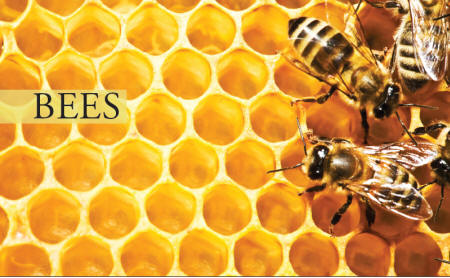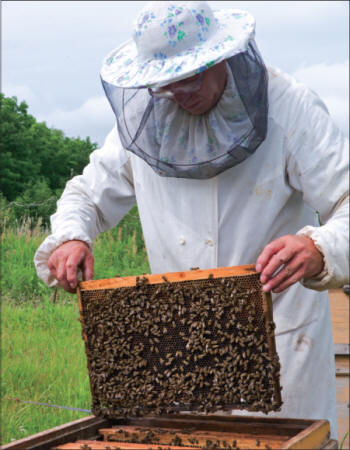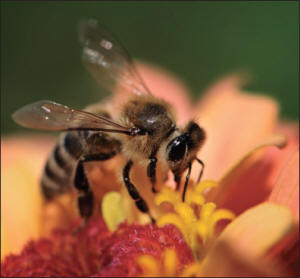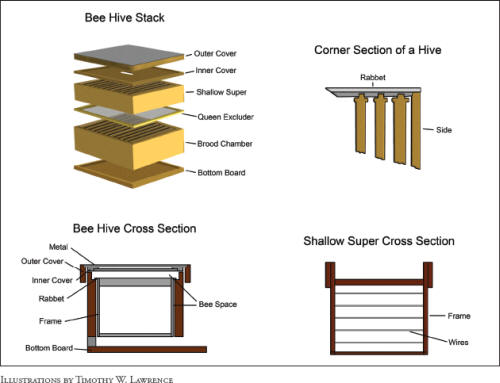
Beekeeping (also known as apiculture) is one of the oldest human industries. For thousands of years, honey has been considered a highly desirable food. Beekeeping is a science and can be a very profitable employment; it is also a wonderful hobby for many people in the United states. Keeping bees can be done almost anywhere—on a farm, in a rural or suburban area, and even, at times, in urban areas (even on rooftops!). Anywhere there are sufficient flowers from which to collect nectar, bees can thrive.
Apiculture relies heavily on the natural resources of a particular location and the knowledge of the beekeeper in order to be successful. Collecting and selling honey at your local farmers’ market or just to family and friends can supply you with some extra cash if you are looking to make a profit from your apiary.
Why Raise Bees?
Bees are essential in the pollination and fertilization of many fruit and seed crops. If you have a garden with many flowers or fruit plants, having bees nearby will only help your garden flourish and grow year after year. Furthermore, nothing is more satisfying than extracting your own honey for everyday use.
How to Avoid Getting Stung
Though it takes some skill, you can learn how to avoid being stung by the bees you keep. Here are some ways you can keep your bee stings to a minimum:
1. Keep gentle bees. Having bees that, by sheer nature, are not as aggressive will reduce the number of stings you are likely to receive. Carniolan bees are one of the gentlest species, and so are the Caucasian bees introduced from Russia.
2. Obtain a good “smoker” and use it whenever you’ll be handling your bees. Pumping smoke of any kind into and around the beehive will render your bees less aggressive and less likely to sting you.
3. Purchase and wear a veil. This should be made out of black bobbinet and worn over your face. Also, rubber gloves help protect your hands from stings.
4. Use a “bee escape.” This device is fitted into a slot made in a board the same size as the top of the hive. Slip the board into the hive before you open it to extract the honey, and it allows the worker bees to slip below it but not to return back up. So, by placing the “bee escape” into the hive the day before you want to gain access to the combs and honey, you will most likely trap all the bees under the board and leave you free to work with the honeycombs without fear of stings.

What Type of Hive Should I Build?
Most beekeepers would agree that the best hives have suspended, moveable frames where the bees make the honeycombs, which are easy to lift out. These frames, called langstroth frames, are the most popular kind of frame used by apiculturists in the United states.
Whether you build your own beehive or purchase one, it should be built strongly and should contain accurate bee spaces and a close-fitting, rainproof roof. If you are looking to have honeycombs, you must have a hive that permits the insertion of up to eight combs.
Where Should the Hive Be Situated?
Hives and their stands should be placed in an enclosure where the bees will not be disturbed by other animals or humans and where it will be generally quiet. Hives should be placed on their own stands at least 3 feet from each other. Do not allow weeds to grow near the hives and keep the hives away from walls and fences. You, as the beekeeper, want to be able to easily access your hive without fear of obstacles.
Swarming
Swarming is simply the migration of honeybees to a new hive and is led by the queen bee. During swarming season (the warm summer days), a beekeeper must remain very alert. If you see swarming above the hive, take great care and act calmly and quietly. You want to get the swarm into your hive, but this will be tricky. If they land on a nearby branch or in a basket, simply approach and then “pour” them into the hive. Keep in mind that bees will more likely inhabit a cool, shaded hive than one that is baking in the hot summer sun.
Sometimes it is beneficial to try to prevent swarming, such as if you already have completely full hives. Removing the new honey frequently from the hive before swarming begins will deter the bees from swarming. Shading the hives on warm days will also help keep the bees from swarming.
Bee Pastures
Bees will fly a great distance to gather food but you should try to contain them, as well as possible, to an area within 2 miles of the beehive. Make sure they have access to many honey-producing plants, which you can grow in your garden. Alfalfa, asparagus, buckwheat, chestnut, clover, catnip, mustard, raspberry, roses, and sunflowers are some of the best honey-producing plants and trees. Also make sure that your bees always have access to pure, clean water.
Preparing Your Bees for Winter
If you live in a colder region of the United States, keeping your bees alive throughout the winter months is difficult. If your queen bee happens to die in the fall, before a young queen can be reared, your whole colony will die throughout the winter. However, the queen’s death can be avoided by taking simple precautions and giving careful attention to your hive come autumn.
Colonies are usually lost in the winter months due to insufficient winter food storages, faulty hive construction, lack of protection from the cold and dampness, not enough or too much ventilation, or too many older bees and not enough young ones.
If you live in a region that gets a few weeks of severe weather, you may want to move your colony indoors, or at least to an area that is protected from the outside elements. But the essential components of having a colony survive through the winter season are to have a good queen; a fair ratio of healthy, young, and old bees; and a plentiful supply of food. The hive needs to retain a liberal supply of ripened honey and a thick syrup made from white cane sugar (you should feed this to your bees early enough so they have time to take the syrup and seal it over before winter).

To make this syrup, dissolve 3 pounds of granulated sugar in 1 quart of boiling water and add 1 pound of pure extracted honey to this. If you live in an extremely cold area, you may need up to 30 pounds of this syrup, depending on how many bees and hives you have. You can either use a top feeder or a frame feeder, which fits inside the hive in the place of a frame. Fill the frame with the syrup and place sticks or grass in it to keep the bees from drowning.
Extracting Honey
To obtain the extracted honey, you’ll need to keep the honeycombs in one area of the hive or packed one above the other. Before removing the filled combs, you should allow the bees ample time to ripen and cap the honey. To uncap the comb cells, simply use a sharp knife (apiary suppliers sell knives specifically for this purpose). Then put the combs in a machine called a honey extractor to extract the honey. The honey extractor whips the honey out of the cells and allows you to replace the fairly undamaged comb into the hive to be repaired and refilled.
The extracted honey runs into open buckets or vats and is left, covered with a tea towel or larger cloth, to stand for a week. It should be in a warm, dry room where no ants can reach it. Skim the honey each day until it is perfectly clear. Then you can put it into cans, jars, or bottles for selling or for your own personal use.
Making Beeswax
Beeswax from the honeycomb can be used for making candles (see page 434), can be added to lotions or lip balm, and can even be used in baking. Rendering wax in boiling water is especially simple when you only have a small apiary.
Collect the combs, break them into chunks, roll them into balls if you like, and put them in a muslin bag. Put the bag with the beeswax into a large stockpot and bring the water to a slow boil, making sure the bag doesn’t rest on the bottom of the pot and burn. The muslin will act as a strainer for the wax. Use clean, sterilized tongs to occasionally squeeze the bag. After the wax is boiled out of the bag, remove the pot from the heat and allow it to cool. Then, remove the wax from the top of the water and then re-melt it in another pot on very low heat, so it doesn’t burn.
Pour the melted wax into molds lined with wax paper or plastic wrap and then cool it before using it to make other items or selling it at your local farmers’ market.
Extra Beekeeping Tips
General Tips
1. Clip the old queen’s wings and go through the hives every 10 days to destroy queen cells to prevent swarming.
2. Always act and move calmly and quietly when handling bees.
3. Keep the hives cool and shaded. Bees won’t enter a hot hive.
When Opening the Hive
1. Have a smoker ready to use if you desire.
2. Do not stand in front of the hive while the bees are entering and exiting.
3. Do not drop any tools into the hive while it’s open.
4. Do not run if you become frightened.
5. If you are attacked, move away slowly and smoke the bees off yourself as you retreat.
6. Apply ammonia or a paste of baking soda and water immediately to any bee sting to relieve the pain. You can also scrape the area of the bee sting with your fingernail or the dull edge of a knife immediately after the sting.
When Feeding Your Bees
1. Keep a close watch over your bees during the entire season, to see if they are feeding well or not.
2. Feed the bees during the evening.
3. Make sure the bees have ample water near their hive, especially in the spring.
Making a Beehive
The most important parts of constructing a beehive are to make it simple and sturdy. Just a plain box with a few frames and a couple of other loose parts will make a successful beehive that will be easy to use and manipulate. It is crucial that your beehive be well adapted to the nature of bees and also the climate where you live. Framed hives usually suffice for the beginning beekeeper. Below is a diagram of a simple beehive that you can easily construct for your backyard beekeeping purposes.
